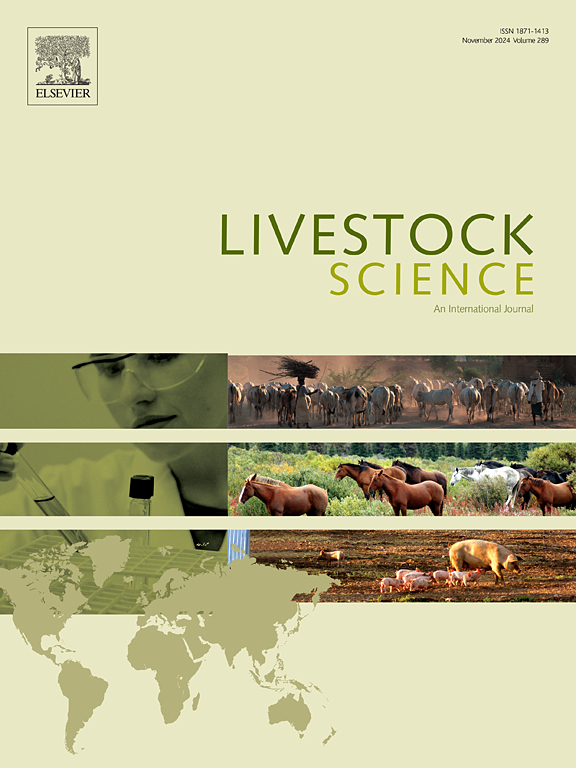Environmental and additive genetic factors that affect artificial insemination success in Latxa dairy sheep breed
IF 1.8
3区 农林科学
Q2 AGRICULTURE, DAIRY & ANIMAL SCIENCE
引用次数: 0
Abstract
In the Latxa breed, flocks within the breeding program make use of high genetic value rams to inseminate their ewes once per year. Despite the relevance of the insemination results in the genetic progress and on farms’ productivity, external and genetic factors that affect artificial insemination (AI) success have not been up to now explored in this sheep population. For that, 135,351 edited AI records from 63,480 inseminated Latxa Cara Negra from Euskadi ewes, using 853 service rams, collected between 2000 and 2021, were used. The outcome of an AI event was treated as a binary response of either success or failure in becoming pregnant. To identify the environmental factors influencing the AI result, a multiple logistic regression was first calculated on a selection of variables related to the ewes, to the ram, and to other non-sex-specific aspects. With relevant variables detected, a threshold model, including the pedigree information of the inseminated ewes and the service rams, was used to estimate the genetic components of the trait in both sexes. Findings show that the AI success is higher in ewes who had the previous parturition from an AI event, in those with a lambing-AI interval longer than 210d, with 3 years and 2 lambings, with high prolificacy and in those having their first parturition at 1 year of age rather than at 2 or 3 years of age. In counterpart, the higher the milk produced in the nearest record before AI date, the poorer the AI results. Furthermore, relevant variability was linked to the year of insemination, the herd and the technician in charge of the insemination procedure. Regarding genetic parameters, heritability values, on the observable scale, and repeatability were 0.057 ± 0.004 and 0.204±0.007 in females and 0.009 ± 0.037 and 0.032 ± 0.002 in males, respectively. These results evidence that the AI success is under moderately low additive genetic control, with the surrounding environmental variables being the strongest controlling factor. An effort to enhance some farm management practices should be encouraged to efficiently improve reproductive results. Although genetic selection on AI success is viable, the genetic progress may be scarce. An option to improve reproduction by means of selective breeding might be the development of a multi-trait index.
影响拉特萨奶羊人工授精成功率的环境因素和附加遗传因素
在拉特夏品种中,育种计划中的羊群每年都会使用高遗传价值的公羊为母羊人工授精一次。尽管人工授精的结果与遗传进步和牧场的生产率息息相关,但迄今为止,尚未对影响人工授精(AI)成功率的外部和遗传因素进行研究。为此,我们使用了 2000 年至 2021 年间收集的 135 351 份经过编辑的人工授精记录,这些记录来自 63 480 头欧斯喀迪母羊的 Latxa Cara Negra 人工授精,使用的公羊数量为 853 头。人工授精的结果被视为怀孕成功或失败的二元响应。为了确定影响人工授精结果的环境因素,首先对母羊、公羊和其他非性别特异性变量进行了多元逻辑回归计算。在检测到相关变量后,利用包括受精母羊和配种公羊血统信息在内的阈值模型来估计雌雄性状的遗传成分。研究结果表明,人工授精成功率较高的母羊包括:上一次产仔来自人工授精的母羊、产羔-人工授精间隔超过 210 天的母羊、产羔 3 年且产羔 2 次的母羊、高产母羊以及首次产羔年龄在 1 岁而非 2 岁或 3 岁的母羊。与之相对应的是,人工授精日期前最近记录的产奶量越高,人工授精结果越差。此外,相关变异与人工授精年份、牛群和负责人工授精程序的技术人员有关。在遗传参数方面,雌性的可观察遗传率和可重复性分别为 0.057 ± 0.004 和 0.204 ± 0.007,雄性的可观察遗传率和可重复性分别为 0.009 ± 0.037 和 0.032 ± 0.002。这些结果表明,人工授精成功率受中等偏低的附加遗传控制,周围环境变量是最强的控制因素。应鼓励加强一些农场管理措施,以有效改善繁殖结果。虽然人工授精成功率的遗传选择是可行的,但遗传进展可能很少。通过选择性育种来提高繁殖率的一种方法可能是开发多性状指数。
本文章由计算机程序翻译,如有差异,请以英文原文为准。
求助全文
约1分钟内获得全文
求助全文
来源期刊

Livestock Science
农林科学-奶制品与动物科学
CiteScore
4.30
自引率
5.60%
发文量
237
审稿时长
3 months
期刊介绍:
Livestock Science promotes the sound development of the livestock sector by publishing original, peer-reviewed research and review articles covering all aspects of this broad field. The journal welcomes submissions on the avant-garde areas of animal genetics, breeding, growth, reproduction, nutrition, physiology, and behaviour in addition to genetic resources, welfare, ethics, health, management and production systems. The high-quality content of this journal reflects the truly international nature of this broad area of research.
 求助内容:
求助内容: 应助结果提醒方式:
应助结果提醒方式:


